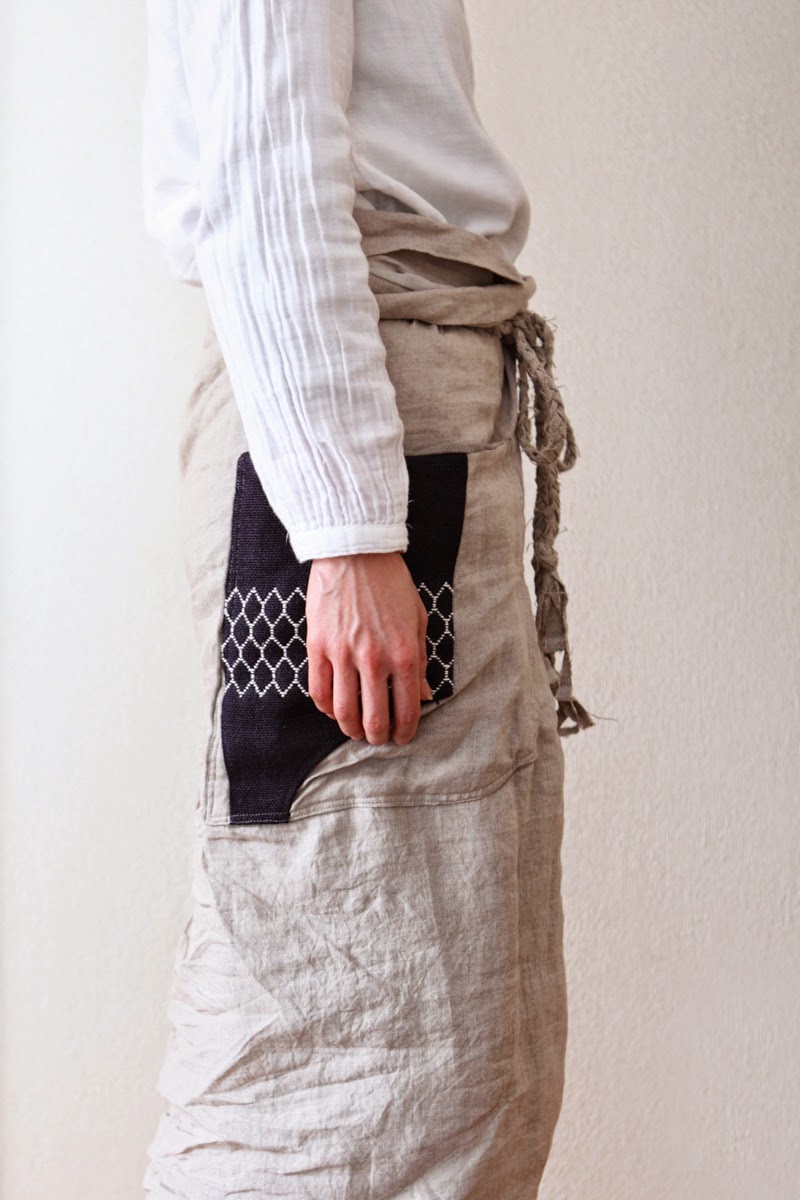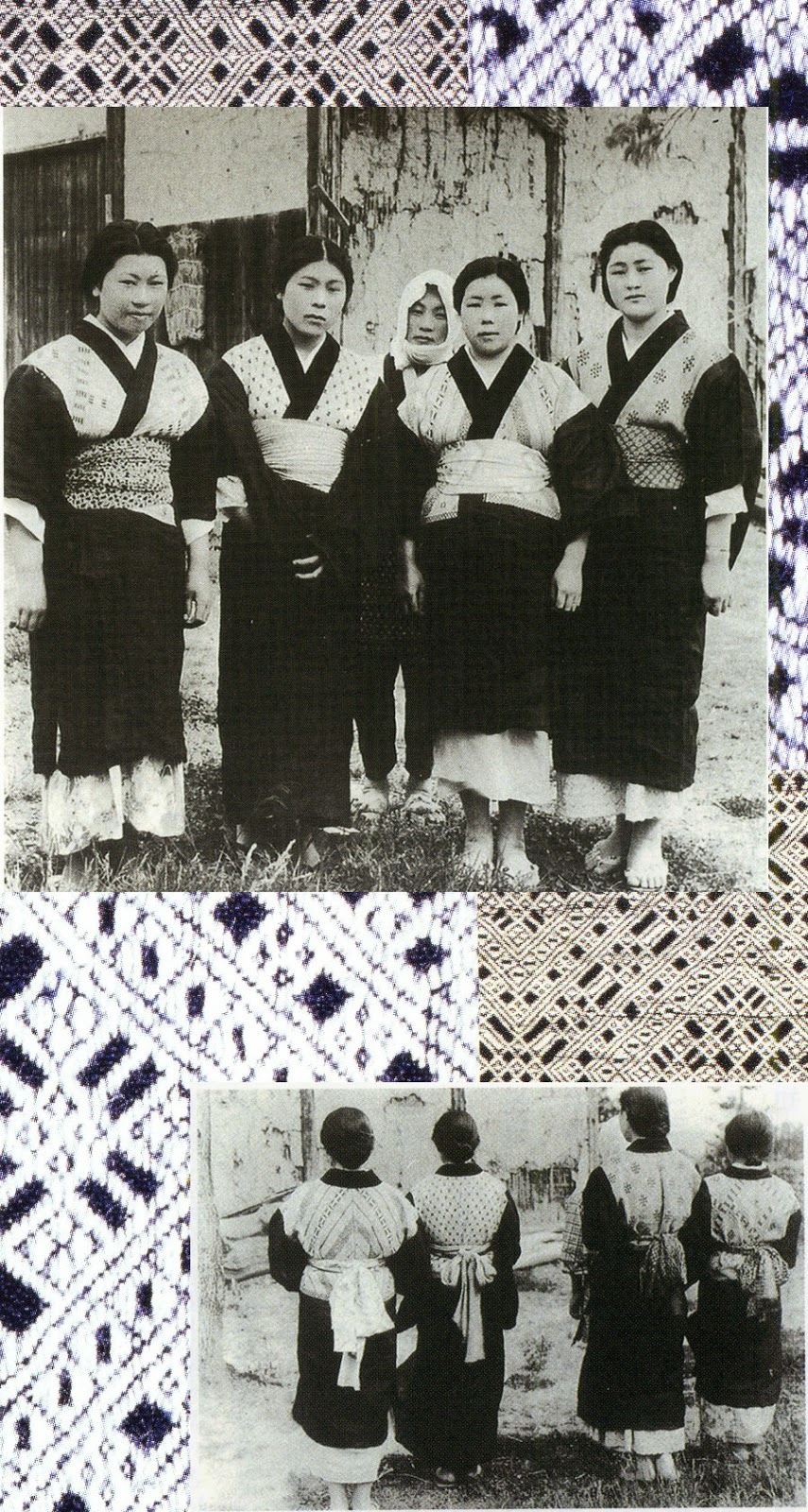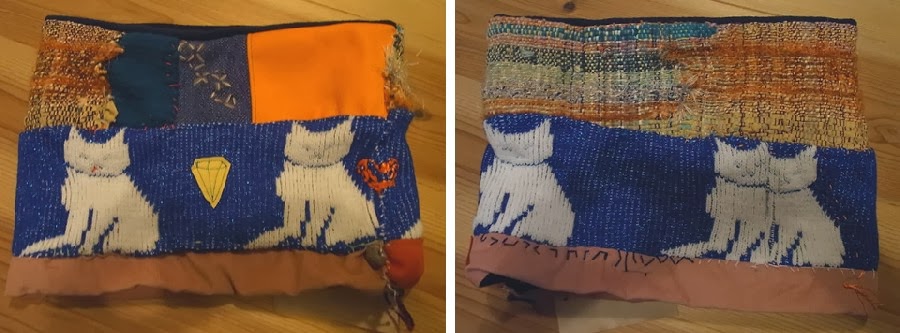 |
| Kogin-Stitch mats displayed at Gallery Soramitsu "Tsugaru Kogin-Stitch Exhibition." (Feb. 2014) |
Let me rewind my clock time a little while back... to the past winter of this year. In a morning of Feb., the date I was visiting Soramitsu Gallery in Nara, where "Tsugaru Kogin Stich Exhibition (Feb.6th-16th, 2014)” was being held, I work up and found the 7 inches of snow having converted my familiar neighborhood landscape to a small snow land. Usually we don't have that much snow in the west of Japan. I thought this snow might be a gift from Aomori, a northern prefecture where the Kigin-Stich was born in the 18th century.
About "Tsugaru-Kogin Stitch"
"Kogin-Stitch" was originally
born in Aomori, a northern prefecture of Japan, the place which the
deep snow completely covers in winter. In the early 18th century a government low constrained the farmers' living style to minimize
their consumption of commodities. The
low prohibited them to wear cotton which was mostly cultivated in the western
areas and consumed only by the regional lords, samurai, and rich merchant-class people. For the farmers, the
locally grown hemp was the only choice of the clothing material. In order to strength the hemp cloths
especially around the shoulders for handling their heavy-carriage duties, the
layers of patches were applied to the garment.
Also most importantly, to give the cloths as much temperature as possible
the air between the hemp threads was tightly filled by sewing in additional hemp
threads. Starting from the spinning of hemp-threads to hand sewing, thread-works became
one of the most important tasks for women.
In the early Meiji period (1868-1912), when
cotton distribution was finally open to the farmers, it started to reach their hands in the form of threads.
The farmers' daughters and wives started to perform more the elaborate
stitches to the garment now for the decorative reason. Stitching over the odd numbers of vertical
threads of the hemp cloths, which had been dyed blue with locally grown indigo, the
various diamond-shaped motifs with very white cotton threads were generated -
today known as "Tsugaru
Kogin-Stitch."
During winter when the farming duties outside were limited, night by night the women moved their hands passionately, as I could
imagine, listening to the silent music of snow falling down. Tanaka Chuzaburo, a scholar of Japanese folklore and archaeology writes in his book(2), "When women in Tsugaru turned to
5 or 6 years old, their mothers handed them threads and needles to start the
Tsugaru-Stitch lessons. By turning into 17
or 18 years old, they had become skillful stitching-masters. At around 20 years old before marrying to
their partners, the women usually owned 5 or 6 at most, 3 at least, of Kogin-Kimono
dresses.” "In the nights of winter,
5 or 6 of young girls got together and enjoyed the group stitching." They shared the inspiration by each other’s original
design and improved one another's skills.
"When the village summer festival was held, when a girl found someone
wearing a fabulous Kogin-Stitch she quietly walked to the girl's back to see the
design close and better. As she went
back home she quickly began stitching before the design in her memory fade away."
Souetsu Yanagi (1889-1961), a philosopher and art-collector, who initiated the Japanese Folk-Craft Movement (1926 - ), traveled all over Japan to
research and re-cultivate the beauty of the regional hand-craft artifacts most
of which had been originally produced in practical needs. When Soetsu discovered the Kogin-Stitch Kimono
dress from the older time of a Tsugaru village, Aomori, he praised saying; "Oh,
Women of Tsugaru with no name, what a beautiful piece of art you have created (1932, Kougei)." Kogin-Stitch was salvaged from the
abandonment and enlightened once more. The
tradition has been inherited to the young generations of Japan today, not limited to Aomori area, but to anyone who is charmed by the beauty of Kogin-Stitch.
Kogin-Stitch Today
 |
| Kogin-Stitch Patterns_graphic table produced by Kogin.net. The number of Kogin-Stitch patterns preserved today can be counted over 300. Each pattern is given a friendly nick-name in Aomori Dialect. The patterns were handed from generation to generation and among villages by conversation and demonstration. I can imagine the cheerful discussions of the women at that time over the namesakes of the various patterns. (A): Flower (B): Stone Pavement (C): "Not of Back-Surface"_The design makes up the back-surface of "Bean (E)" stitch. The name literally means "it is not just a back-surface but one kind of a design." (D): Tied-Flowers (E): Bean (F): Gourd (G): Linked Flowers (H): Fish's Scale (I): (Supposedly) Shape of Twisted Legs (J): Beans and Flowers Overlapped (K): Shape of Hand-Railed Wooden Fence (L): Fish's Scale (M): Cattle (N): Horse's Bits (O): (Unnamed) (P): Fish's Scale (Q): Flowers Overlapped with Threads (R): Spider (S): Feather of Arrow (T): Linked Horse's Bits (U): Horse's Bits (V): #-Shape of Wooden Rails around Wells (W): Symbolizing the action of "Yasuko wo Kakeru"- letting someone tumble by foot - is dangerous, the sign "X" here means "not a good thing." The names can lively tell us that Kogin-Stitching was really a great part of the Life of Tsugaru People. |
As the rail-road was extended from Tokyo to
Aomori between 1891 and 1894, the amount of material supply to the northern
areas dramatically increased including cotton cloths. People enjoyed the arrival of cotton cloths which were strong and warm enough in themselves. The women gradually stopped their hands for stitching. Kogin-Stiched, hemp Kimono dress was no longer in
its production-peak.
Kogin-Stitch Today
- CHIO YONEYAMA COGIN WORKS -
 | ||
3 Above: "Otoko Momonga (Manly Flying Squirrel)"
100% Cotton Threads and 100% Linen Cloths.
The collaboration pieces produced for "Kaksi x Chiho Yoneyama, Duo Exhibition (Nov.2012)"
|
Chiho Yoneyama is one of the young inheritors of Kogin-Stitch today, who has crowned just more colors to the tradition. As she grew up in Aomori, Chiho's first experience of Kogin-Stitch was at the home-duty class in her junior high school. Since then Chiho has become to realize that Kogin-Stitch is a precious piece of legacy of her homeland, and that it can nurture our modern life in affectionate manners.
 |
| 4 Above: "Kogin Zabuton (Kogin Cushion)" 100% Cotton Threads and 100% Linen Cloths. They can be one-piece dresses or shor-skirts by following the folding recipe.The collaboration pieces produced for "Kaksi x Chiho Yoneyama, Duo Exhibition (Nov.2012)" at Roku Jigen(6th Dimension) in Tokyo, Japan. Pictures taken from Chiho Yoneyama Cogin Works |
 | |
|
 |
| This is the choice for myself. I love the puffiness of the cotton threads over the linen cloth. (Paper Underneath): "White Postcard" by Kogin.net |
 |
| "Cogin Brooch Bird " Sea Gull Pattern (Left), Gypsophila Pattern (Right). 100% Cotton Threads and 100% Linen Cloths. Size: 85 x 85 mm Color: Beige, Yellow, Blue. Pictures from Chiho Yoneyama Cogin Works |
・
・
・
・
・
Here is a beautiful video clip showing Chio's workplace and time. Her hands delicately move to create new Kogin-Stitch works that nourish the legacy of her homeland.
(Clip Produced by ICONI Design)
- IEMASA YAMAHATA -
 |
| "Kogin-Stitch Embroidery of One's Life" Tapestry Installation Work by Iemasa Yamahata at Gallery Soramitsu (Feb. 2014). Iemasa produced "Kogin Typography" which follows the stitching rules of Kogin-Stitch graphics. See the below for the structure of the work. |
An artist and designer, Iemasa Yamahata is another young inheritors of Kogin-Stitch who takes an unique approach to the legacy with his graphic design expressions. When Iemasa was in his high school, the teacher of fashion design class told him about a local exhibition of Tsugaru's traditional dresses. He visited the place and found vintage Kogin-Stitched Kimonos and just stood in front of the pieces, holding his breath because of their "shockingly elaborate designs and the graceful color combination of indigo-blue and white." Then his fascination with Kogin-Stitch led him to become a "Kogin Artist" and eventually he has found an association called Kogin.net in Aormori by which he shares his passion with people through research activities and creative events. As Iemasa describes; "Kogin Stitch serves us a cute, fun, cool, interesting, comfortable, simple, healthy, economical, pleasant, and eco-friendly form of life style." "It was created by our ancestors' wisdom, which I would love the people worldwide to know about. My wish is that one day Kogin Stitch will serve comfort to everyone on the globe."
- from the greeting message at Kogin.net -
 |
| Print Work of Kogin-Stitch patterns with punched out holes on white papers (Front Left Side). & Jacket and Trousers of Farmers Work Clothes Style (Right Side) |
 |
| Scarves and Caps printed with Kogin-Stitch Patterns. |
 |
| Iemasa translates Kogin-Stitch patterns into elaborate graphic works on papers. How sweet to find the puffiness of the threads is now reproduced with the ink. "Orange Postcard" by Kogin.net |
 |
| By coloring, connecting and expanding, Iesmasa orchestrates the traditional patterns to create new. Entertaining paper set of 10 different designs might give new ideas to one's craft-work projects. "Free Paper x 10 kinds" by Kogin.net |
For Kogin-goods information please check the Kogin Shop.
今年冬の2月14日、列島各地が記録的な雪に見舞われ「ホワイト・バレンタインデー」となりました。雪が積もることの少ない関西も例にもれず、その日の朝窓を開けた瞬間に見慣れた朝の景色がまるで「雪国」のそれにすっかり変わっていたのを
小さな驚きの声をあげて迎えました。そして心に浮かんだのはちょうどその日、訪れようと予定していた奈良の「空櫁」ギャラリーで開催中の『Tsugaru こぎん刺し展』のこと。まるでこの雪が、遠い津軽の国から贈られたプレゼントの様に思えたのです。
青森県津軽地方で生まれた「こぎん刺し」は、綿の着用をゆるされず、厳しい冬の気候に暖をとるため麻布に貴重な綿糸を刺した先人の知恵から生まれました。そしてその知恵はやがて、人々の暮らしを彩り、また語りつぐ幾つもの「もどこ(=紋様)」の花を咲かせ、世代から世代へと誇りと共に大切に継承され、こぎん刺しを纏った着物は今日の日本にとってかけがえのない工芸財産となりました。ページ前半に転載させて頂いた、こぎん刺し着物を着た女性達のポートレート写真を見た時、私は息をのみました。厳しい寒冷地での暮らしを生きる女性として私が想像していた表情とはかけ離れていたのです。まっすぐにこちらを見据える瞳に、ご自身を着飾る「作品」であるこぎん刺しを創り着る誇りと、自信が力強くみなぎる、美しい女性のエネルギーを感じたのです。
空櫁ギャラリーでの『Tsugaru こぎん刺し展』を飾る、手芸作家の米山知歩さんとアーティストでありデザイナーの山端家昌さんは、そんな「こぎん刺し」のスピリットを現代に受け継ぐおふたりです。青森を拠点に活動されているおふたりの作品からは、「こぎん刺し」は私たちの生活に優しく強いエネルギーを吹き込んでくれる、という共通した想いを感じたのでした。
--------------------------------------------------------------------------------
米山知歩さんの作品:
『おとこモモンガ』『こぎんざぶとん』『Cogin Brooch Bird』
(chiho yoneyama cogin works サイトより)
山端家昌さんの作品:
『人生のこぎん模様(「生」「結」「別」)』三連タペストリー
青い布地に白い「koginタイポ」で表された模様は、記念日や誕生日といった個人にとって大切な意味を持つ数字。「生」では山端さんご自身の誕生年月日と、生まれた時の体重が、「結」では奥様との結婚記念年月日と、おふたりの誕生月日が示されている。タイプ模様を「総刺し」プリントした作品上部の刺し模様の下には、ふたつのテーマの記念写真(出生時と結婚披露宴より)がそれぞれ布かれる。「別」では、山端さんにとって尊敬する師である、こぎん刺し作家・鎌田光展氏の人生誕生と終焉の日付が表されている。
こぎんウェア上下と、白い紙に穴あけされたこぎん模様のディスプレイ
(ギャラリー空櫁「Tsugaru こぎん刺し展」展示作品)
kogin 『Whiteポストカード』『オレンジポストカード』『自由紙x10種類』
koginプリントのマフラー&ニット帽
(ギャラリー空櫁「Tsugaru こぎん刺し展」販売作品)
※お問い合わせ先:kogin shop
--------------------------------------------------------------------------------
津軽こぎん刺しの歴史についての参考/引用文献&サイト:
田中忠三郎 (2009) みちのくの古布の世界 河出書房新社 10,11,16
秋岡芳夫 (1983) 日本の芸① みちのく至芸の里 集英社 1, 94-95
津軽こぎん刺しの歴史/津軽こぎん刺し模様集
有限会社弘前こぎん研究所・三浦佐知子さんのインタビューページ
こぎん刺しタグページ





































